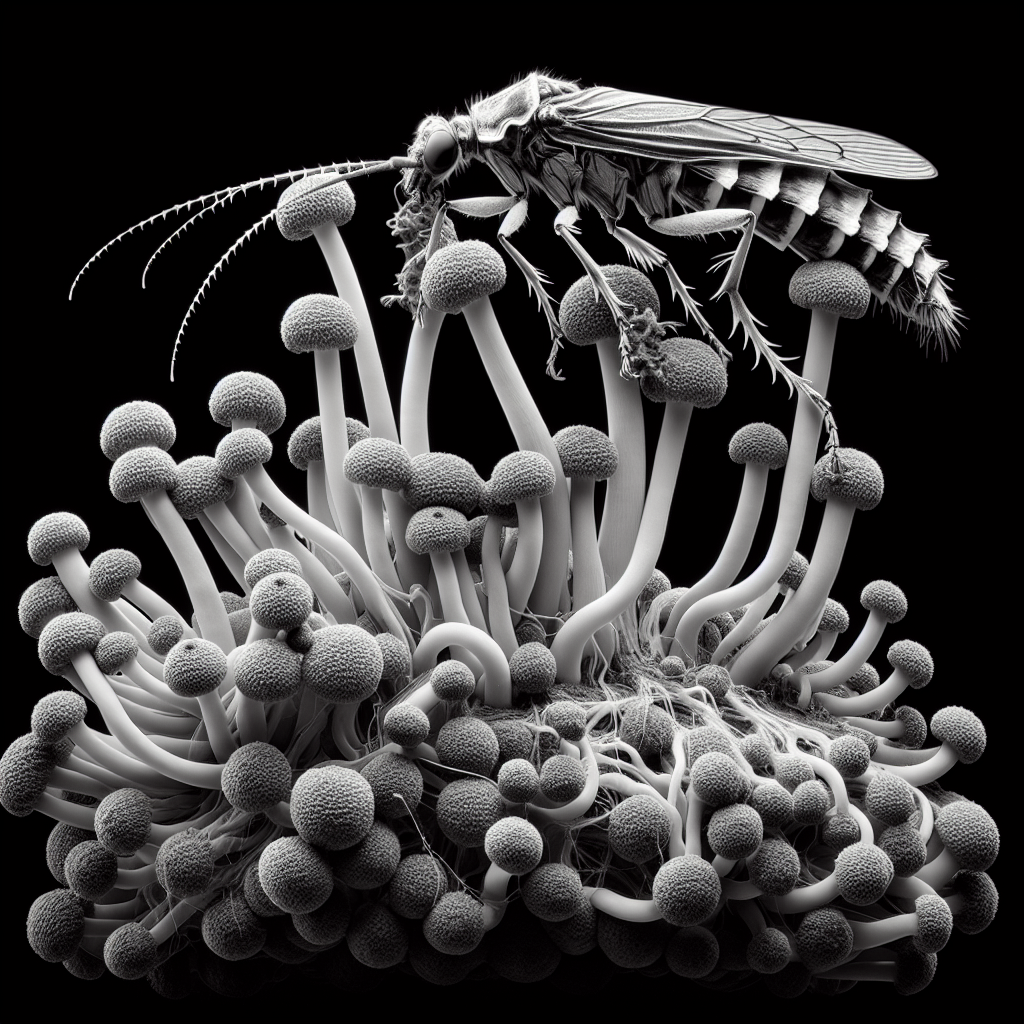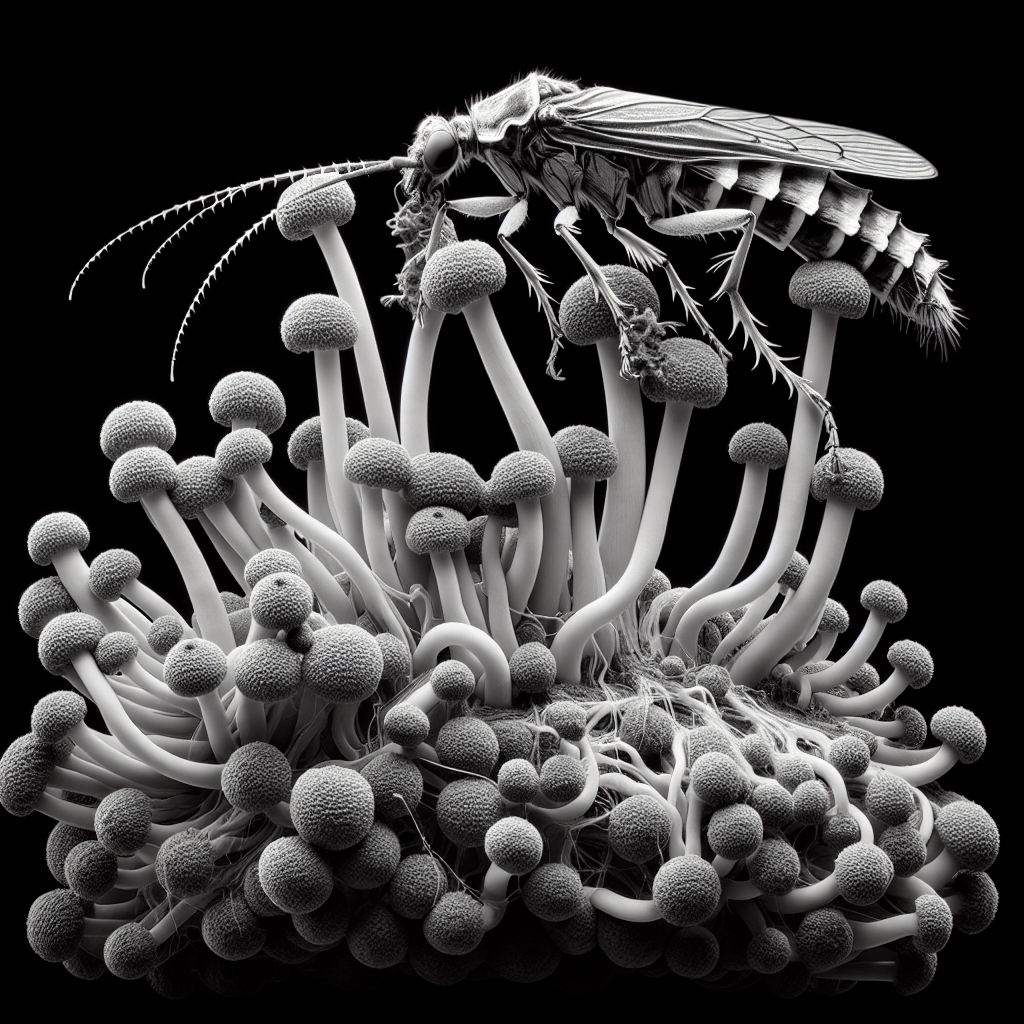In the intriguing world of fungi, the relationship between Mycelium and Cordyceps presents a fascinating topic of study. You’ll be enlightened to comprehend this multifaceted connection, as we explore the characteristics of Mycelium – the vast underground network of fibers that shape the foundation of various fungal species – and Cordyceps – the exceptional fungi known for its medicinal feats and parasitic properties. This article promises to take you through the unique and interdependent relationship between these two integral elements of mycology, Ne extent to which they influence each other, and their consequential role in shaping the environment and facilitating our health.
Understanding Mycelium
Definition of Mycelium
Mycelium is the vegetative part of a fungus or fungus-like bacterial colony, constituting a mass that consists of a branched network of hyphae or thread-like structures. Hyphae are often hidden in the soil or within another substrate, gaining nutrients needed for growth. Overall, the mycelium serves as the primary site for nutrient absorption, but it also plays an important role in reproduction for many fungi.
Structure and Formation of Mycleium
Mycelium is composed of hyphae, which are tiny, thread-like structures that group together. This organization allows fungi to effectively absorb nutrients from the environment. Each hypha consists of one or more cells enclosed by a cell wall. The mycelium structure is formed when fungal spores germinate and produce hyphae, which then grow and branch, interconnect and potentially fuse, forming an intricate network.
Role and Importance of Mycelium in Fungi Life Cycle
Mycelium plays an integral role in the life cycle of fungi. Not only is it the primary phase during which the fungus absorbs nutrients, but it also contributes to reproduction. A fungus can produce spores sexually or asexually, but regardless of the method, the resulting spores give rise to new mycelium. The absorbed nutrients support the growth, development, and survival of the fungi, as well as the production of spores for future generations.
Exploring Cordyceps
Definition of Cordyceps
Cordyceps is a genus of ascomycete fungi, notable for its parasitic nature. The genus comprises hundreds of species, each of which is parasitic on a specific kind of insect or other arthropods. Most species of Cordyceps are renowned for their medicinal properties, particularly Cordyceps sinensis, now known as Ophiocordyceps sinensis, and used in traditional Chinese and Tibetan medicine.
Lifecycle and Reproduction of Cordyceps
Cordyceps has a fascinating and complex lifecycle. The fungus starts life as a minute spore. When the conditions are favorable, the spore germinates, burrowing into the body of an insect, where it begins to grow and take over its host. It then morphs and sends out mycelium, eventually killing and consuming the insect. After completely filling the host’s body with mycelium, it produces a fruiting body that emerges from the host, releasing spores, thus completing the life cycle.
Different Species of Cordyceps
There are over 400 known species of Cordyceps, each one known to parasitize a certain type of insect. Notably, there is Cordyceps militaris, which attacks moth pupae and larvae, and Ophiocordyceps sinensis, infamous for its parasitic relationship with the ghost moth larvae. Each species exhibits different growth conditions, morphological features, and medicinal properties.
The Life Cycle of Cordyceps and Its Relationship with Mycelium
Mycelium Phase in Cordyceps Lifecycle
The mycelium phase in the Cordyceps lifecycle is when the fungus begins to develop within its host. After the spore burrows into the insect, it germinates and starts to grow, leading to the formation of threadlike mycelial networks within the host’s body. This mycelium phase is critical for it eventually takes control of the host’s body and uses it as a source of nutrients.
How Does Cordyceps Utilize Mycelium
Cordyceps utilizes the mycelium in a unique and fascinating way. Once the fungus has successfully entered the insect host, it sends out mycelium that gradually takes over the host’s body. The mycelium then feeds on the insect from the inside out, using the nutrients from the host to grow and develop. The host essentially becomes a living incubator for the growing mycelium, resulting in the fungus spreading throughout the host’s body.
Features of Cordyceps Mycelium
Cordyceps mycelium is recognized for its distinguishing features. It exhibits cordyceptin, a bioactive metabolite which plays a key role in the fungus’s exceptional medicinal attributes. It also presents aggressive parasitic properties, enabling it to use its host as both habitat and food. The extended hyphal network has bi-directional fluid flow and is designed to exploit nutrients effectively within the host, thus supporting optimal growth.

Natural Environment of Mycelium and Cordyceps
Habitat Preferences
Cordyceps species show preferences for diverse habitats but are mainly found in humid, temperate, and tropical forests. The optimum habitat is usually where there is an abundance of their specific insect hosts. Mycelium, on the other hand, is not limited to any particular habitat and is ubiquitous in soil, decaying plant matter, and other organic materials.
Environmental Conditions for Optimal Growth
Cordyceps and mycelium requires specific environmental factors for optimal growth. The right balance of temperature, humidity, light, and nutrient content is crucial. Both Cordyceps and mycelium can grow in numerous conditions but tend to flourish in humid environments, with moderate temperatures, and in the absence of direct, intense light.
Interactions with other Organisms
The interactions of Cordyceps and mycelium with other organisms are enormously influenced by their respective roles in nature. As a parasite, Cordyceps’ interaction with its host often results in the host’s demise. Mycelium, however, engages symbiotically with other organisms, aiding in the decomposition of organic waste and contributing to nutrient cycling in ecosystems.
Impact of Mycelium on Cordyceps Growth and Development
How Mycelium Supports Cordyceps Development
Mycelium plays a vital role in the growth and development of Cordyceps. As the primary growth stage of the fungus, the mycelium is responsible for absorbing nutrients from the host or substrate. These nutrients fuel the metabolic processes which support the Cordyceps development and maturation, resulting in effective reproduction and propagation.
Impact on Cordyceps Reproduction
The mycelium impacts Cordyceps reproduction by providing the medium and necessary resources for the formation of fruiting bodies, specifically stromata, which then produce and release copious amounts of spores. This cycle supports the continuity and widespread dispersion of the Cordyceps fungus.
Mycelium Contribution to Cordyceps Survival
Beyond facilitating growth and reproduction, the mycelium also contributes to Cordyceps’ survival. By invading the host’s body with hyphae, the fungus can utilize the host’s resources for sustenance and development. This provides the fungus with a unique survival strategy that allows it to overcome unfavorable environmental conditions.
Cordyceps as a Parasite
Parasitic Behavior of Cordyceps
Cordyceps’ primary characteristic is its parasitic nature. Each species targets a specific insect or arthropod host. The spores infiltrate the host, following which it sends out mycelium that progressively consumes and eventually kills the host. The host’s body then becomes a nutrient source and site for the fungus to mature and produce fungi structures that are ready to release new spores.
Interaction between Cordyceps and Its Host
The interaction between Cordyceps and its host is, unfortunately, lethal for the host. Once infiltrated, the fungus begins its life cycle within the host, where it grows and develops by consuming the host tissues. This eventually results in the host’s death and the emergence of the fruiting bodies of Cordyceps from the host’s carcass to release spores.
Host Influence on Cordyceps Mycelium
The host significantly influences Cordyceps mycelium both in its growth process and its ability to produce bioactive compounds. The nutritional composition and physical attributes of the host directly influence the mycelium’s growth and the resultant production of metabolic compounds.
Cultivation of Cordyceps and Mycelium
Methods of Cultivating Cordyceps
The cultivation of Cordyceps has become increasingly popular due to its medicinal properties. The methods range from utilizing grains as substrates to reproduce both the insect host and Cordyceps growth stages to the employment of intricate semi-synthetic mediums. These methods aim to replicate the biomass and bioactive compound production observed in the natural Cordyceps lifecycle.
Importance of Mycelium in Cultivation
Mycelium has an essential role in cultivating Cordyceps. As the primary vegetative growth stage, it is responsible for the extraction and utilization of nutrients from the substrate, the development of the fungus within the substrate, and the eventual formation of fruiting bodies.
Challenges in Cordyceps Cultivation
Despite advancements, cordyceps cultivation presents numerous obstacles. These include the difficulty of reproducing the fungus-host interaction and the inconsistency in the bioactive compound concentrations in artificially cultured Cordyceps compared to naturally occurring specimens. Ongoing research strives to tackle these challenges and improve cultivation methods.
Medicinal Properties of Cordyceps
Active Compounds in Cordyceps
Cordyceps is renowned for its bioactive compounds, which contribute to its medicinal properties. These include cordycepin, cordycepic acid, polysaccharides, and various nucleosides. These compounds demonstrate significant biological activities, with potential applications in traditional medicine and pharmaceuticals.
Health Benefits Associated with Cordyceps
Cordyceps offers numerous health benefits, including boosting immunity, enhancing athletic performance, and potential anticancer effects. It is also recognized for its antioxidant, anti-inflammatory, and antidiabetic properties, making it a highly regarded supplement in the wellness market.
Scientific Studies on Cordyceps
Extensive scientific research is being conducted on Cordyceps to validate and understand its medicinal properties. Studies have shown promising results regarding its influence on immunity, kidney function, cancer treatment, and chronic illnesses. Current research is working towards gaining further understanding of how these benefits are achieved and how they can be optimized.
The Harvesting and Processing of Cordyceps
How Cordyceps is Harvested
Cordyceps’ harvesting, particularly targeting the Ophiocordyceps sinensis, occurs once the fruiting body has fully developed and matured on the host insect. Care is taken to ensure that the fungus and the intact host are excavated as they are valued together in traditional medicine.
Processing Methods
Once harvested, Cordyceps undergoes several processing steps before consumption. This usually entails thorough cleaning, followed by drying to preserve the fungus. Depending on the end-use, Cordyceps may be pulverized into powder, extracted, or packaged as whole fruiting bodies.
Preserving the Medicinal Properties
Preserving the medicinal properties of Cordyceps is of utmost importance during harvesting and processing. Appropriate drying methods are crucial for maintaining the valuable bioactive compounds. Incorrect practices could degrade these compounds and decrease the potency of Cordyceps.
Future Research and Applications of Cordyceps and Mycelium
Potential Areas of Research
Significant potential exists for new research into Cordyceps, particularly regarding its bioactive compounds and possible applications in medicine and wellness. There is also scope for research into the genetic modification of Cordyceps in order to achieve better cultivation success and consistency in bioactive compound production.
Possible Future Applications
There are many potential future applications for Cordyceps and mycelium. In addition to current uses in dietary supplements and traditional herbal medicines, they could play a role in developing new therapeutic drugs, boosting agricultural productivity, and advancing environmental sustainability initiatives such as waste decomposition.
Challenges and Limitations
While Cordyceps and mycelium present numerous opportunities, they also pose certain challenges and limitations. These include the need for specialized cultivation techniques, the difficulty of replicating specific bioactive compounds in laboratory conditions, and the ongoing need to understand and leverage their complex biological processes maximally. Nevertheless, the future holds great promise for these fascinating elements of our natural world.
